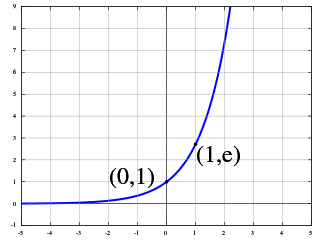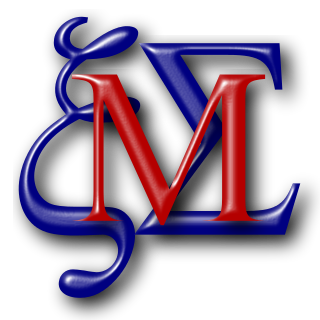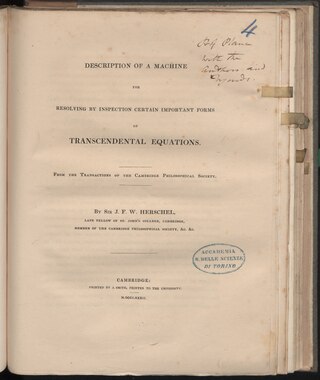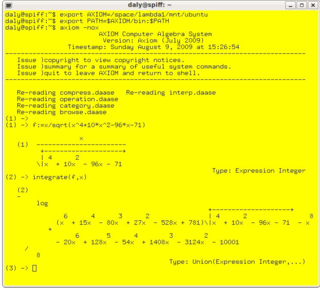
The exponential function is a mathematical function denoted by or . Unless otherwise specified, the term generally refers to the positive-valued function of a real variable, although it can be extended to the complex numbers or generalized to other mathematical objects like matrices or Lie algebras. The exponential function originated from the operation of taking powers of a number, but various modern definitions allow it to be rigorously extended to all real arguments , including irrational numbers. Its ubiquitous occurrence in pure and applied mathematics led mathematician Walter Rudin to consider the exponential function to be "the most important function in mathematics".
A computer algebra system (CAS) or symbolic algebra system (SAS) is any mathematical software with the ability to manipulate mathematical expressions in a way similar to the traditional manual computations of mathematicians and scientists. The development of the computer algebra systems in the second half of the 20th century is part of the discipline of "computer algebra" or "symbolic computation", which has spurred work in algorithms over mathematical objects such as polynomials.

Maple is a symbolic and numeric computing environment as well as a multi-paradigm programming language. It covers several areas of technical computing, such as symbolic mathematics, numerical analysis, data processing, visualization, and others. A toolbox, MapleSim, adds functionality for multidomain physical modeling and code generation.

Maxima is a computer algebra system (CAS) based on a 1982 version of Macsyma and is still in development today. It is written in Common Lisp and runs on all POSIX platforms such as macOS, Unix, BSD, and Linux, as well as under Microsoft Windows and Android. It is free software released under the terms of the GNU General Public License (GPL).

In mathematics, exponentiation is an operation involving two numbers: the base and the exponent or power. Exponentiation is written as bn, where b is the base and n is the power; this is pronounced as "b (raised) to the n". When n is a positive integer, exponentiation corresponds to repeated multiplication of the base: that is, bn is the product of multiplying n bases:
In symbolic computation, the Risch algorithm is a method of indefinite integration used in some computer algebra systems to find antiderivatives. It is named after the American mathematician Robert Henry Risch, a specialist in computer algebra who developed it in 1968.
Axiom is a free, general-purpose computer algebra system. It consists of an interpreter environment, a compiler and a library, which defines a strongly typed hierarchy.
Aldor is a programming language. It is the successor of A# as the extension language of the Axiom computer algebra system.
In calculus, symbolic integration is the problem of finding a formula for the antiderivative, or indefinite integral, of a given function f(x), i.e. to find a differentiable function F(x) such that
A♯ is an object-oriented functional programming language distributed as a separable component of Version 2 of the Axiom computer algebra system. A# types and functions are first-class values and can be used freely together with an extensive library of data structures and other mathematical abstractions. A key design guideline for A# was suitability of compiling to portable and efficient machine code. It is distributed as free and open-source software under a BSD-like license.

SageMath is a computer algebra system (CAS) with features covering many aspects of mathematics, including algebra, combinatorics, graph theory, group theory, differentiable manifolds, numerical analysis, number theory, calculus and statistics.
The scale space representation of a signal obtained by Gaussian smoothing satisfies a number of special properties, scale-space axioms, which make it into a special form of multi-scale representation. There are, however, also other types of "multi-scale approaches" in the areas of computer vision, image processing and signal processing, in particular the notion of wavelets. The purpose of this article is to describe a few of these approaches:

In applied mathematics, a transcendental equation is an equation over the real numbers that is not algebraic, that is, if at least one of its sides describes a transcendental function. Examples include:
The expression problem is a challenging problem in programming languages that concerns the extensibility and modularity of statically typed data abstractions. The goal is to define a data abstraction that is extensible both in its representations and its behaviors, where one can add new representations and new behaviors to the data abstraction, without recompiling existing code, and while retaining static type safety. The statement of the problem exposes deficiencies in programming paradigms and programming languages, and as of 2023 is still considered unsolved, although there are many proposed solutions.

In mathematics and computer science, computer algebra, also called symbolic computation or algebraic computation, is a scientific area that refers to the study and development of algorithms and software for manipulating mathematical expressions and other mathematical objects. Although computer algebra could be considered a subfield of scientific computing, they are generally considered as distinct fields because scientific computing is usually based on numerical computation with approximate floating point numbers, while symbolic computation emphasizes exact computation with expressions containing variables that have no given value and are manipulated as symbols.
Stephen M. Watt, a computer scientist and mathematician, is past Dean of the Faculty of Mathematics and Professor in the David R. Cheriton School of Computer Science at the University of Waterloo, Ontario, Canada.
IBM Quantum Platform is an online platform allowing public and premium access to cloud-based quantum computing services provided by IBM. This includes access to a set of IBM's prototype quantum processors, a set of tutorials on quantum computation, and access to an interactive textbook. As of February 2021, there are over 20 devices on the service, six of which are freely available for the public. This service can be used to run algorithms and experiments, and explore tutorials and simulations around what might be possible with quantum computing.
Patrizia M. Gianni is an Italian mathematician specializing in computer algebra. She is known for her early research on Gröbner bases including her discovery of the FGLM algorithm for changing monomial orderings in Gröbner bases, and for her development of the components of the Axiom computer algebra system concerning polynomials and rational functions.









